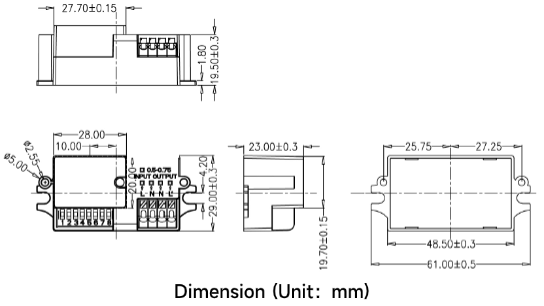
| Input | Voltage Rage | 220-240Vac 50/60Hz | |
| Rated Voltage | 230Vac | ||
| Stand-by Power | ≤0.1W | ||
| Surge Test | 1KV(L/N,EN61000-4-5) | ||
| Output | Working Mode | ON/OFF | |
| Type of Load | Inductive or Resistive Load | ||
| Load Capacity | 200W@230Vac(Inductive Load), 400W @230Vac(Resistive Load) | ||
| Max. Surge Capacity | 20A (50% Ipeak, twidth =500uS, 230Vac full load, cold start); 40A (50% Ipeak, twidth =200uS, 230Vac, full load, cold start) |
||
| Sensing parameters | Operating Frequency | 5.8 GHz ±75 MHz,ISM Wave Band | |
| Transmitting power | 1mW Max | ||
| Hold time | 5S/30S/1min/3min/5min/10min/20min/30min | ||
| Detection | 100%/75%/50%/25% | ||
| Daylight | Normal Daylight Sensor | 2Lux/10Lux/25Lux/50Lux/Disable (Ambient diffusion status) |
|
| Detection radius (100% detection area) |
Ceiling Mounting at 3m height: 0.3m/S ≥3.5m,1m/S ≥2.5m Wall Mounting at 2m height: 0.3m/S ≥8m,1m/S ≥4m |
||
| Mounting Height | Typical Value: 3m(4m Max) | ||
| Detecting Angle | Ceiling mount 150° | ||
| Operating Environment | Operating Temperature | -25℃~60℃ | |
| Storage Temperature | ‘-40℃~80℃ Humidity: ≤85%(Non-condensing) |
||
| Maximum shell temperature(Tc) | 80℃ | ||
| Certification Standards | Safety Standards | EN61058-1-2,EN61058-1 | |
| EMC Standards | EN61058-1,EN61000-3-2,EN61000-3-3,EN62479 EN301489-1,EN55015,EN300440 |
||
| Environmental Requirement | Compliant to RoHS | ||
| Certificate | CE,RED,TUV | ||
| Other | Wiring | Press-in Type Terminals, wire diameter:0.5-0.75mm2 | |
| IP Rating | IP20 | ||
| Protection Class | Class II | ||
| Installation | Built-in | ||
| Dimension | 61.0*29.0*23.0mm | ||
| Package | Bubble bag+Clapboard + Carton(K=A) | ||
| Net Weight | 25.2g | ||
| Lifetime | 5 years warranty @Ta 230V full load | ||
Initialization
After power on, the sensor automatically turns on light to 100% brightness and turns off light in 10 seconds. During initialization, sensor is not able to detect movement.
Factory Setting
Detection Area: 100%, Hold Time: 5S, Daylight Sensor: Disable.
Application Notice
(1) Sensor should be installed by a professional electrician. Please turn off power before installing, wiring, or setting the DIP switches.
(2) Microwaves cannot penetrate metal. Do not place product in a closed or a half-closed metal lamp. Neither metal nor glass is not allowed to cover above the product. If antenna needs to pass through the metal plate, please ensure that the top of sensor is close to the metal plate.
(3) The distance among sensors should be greater than two meters. Keep sensor away from switches, routers and other wireless devices to avoid radio interference, more than two meters. The antenna surface of microwave module should be away from input AC and output DC to avoid low or high frequency signals affecting the normal operation of microwave sensor’s antenna.
(4) Vibration signals will be regarded as moving signals to trigger sensor. Installing sensor should be away from the object that vibrates for a long time, such as large metal equipment, pipes, air conditioning outlets, exhaust vents, smoke exhaust machine ports, shaking fans, etc. Pets in detecting area may trigger sensing.
(5) Sensor is for indoor use only. The waterproof effect for outdoor or half-outdoor use will be affected. Wind, rain, and moving objects may cause false triggering. When the sensor is installed in a metal lamp, on a metal reflective surface, or in a narrow enclosed device, the microwave will be reflected repeatedly and cause false triggering. Please reduce the sensitivity of sensor or contact manufacturer for technical support.
(6) This model is suitable for ceiling mounting. If wall mounting, the detecting area will enlarge which makes microwave penetrate wall or light not turn off, and please change sensitivity to 10%. If 10% is useless, please avoid wall mounting or contact the manufacturer for technical support.
(7) Due to continuous improvement, the contents of this instruction will be changed without prior notice.
(8) The daylight thresholds are measured on a sunny day without shadow and in an ambient light diffuse reflection status. Different environment and climate cause different brightness values that daylight sensor measures.
(9) Sensitivity area is related to moving speed of objects, size of moving objects, mounting height, mounting angle, working environment, reflecting materials and etc.
(10) Given detecting area is typical value that was measured by 165cm high testers in an indoor open environment.
(11) To achieve the best detection results, the antenna surface of microwave sensor should be at least five millimeters higher than surrounding plates, such as aluminum substrate, glass fiber board and so on.
(12) When ambient temperature is over 80’C, over temperature protection may be triggered (automatic recovery after cooling)
(13)The AC incoming line needs to keep a distance of more than 10mm from the BUCK inductance, Otherwise it will cause conduction to fail.

*The sensor is allowed to be connected to one load only.
The sensor may be damaged if connecting more than one load.
N/A
